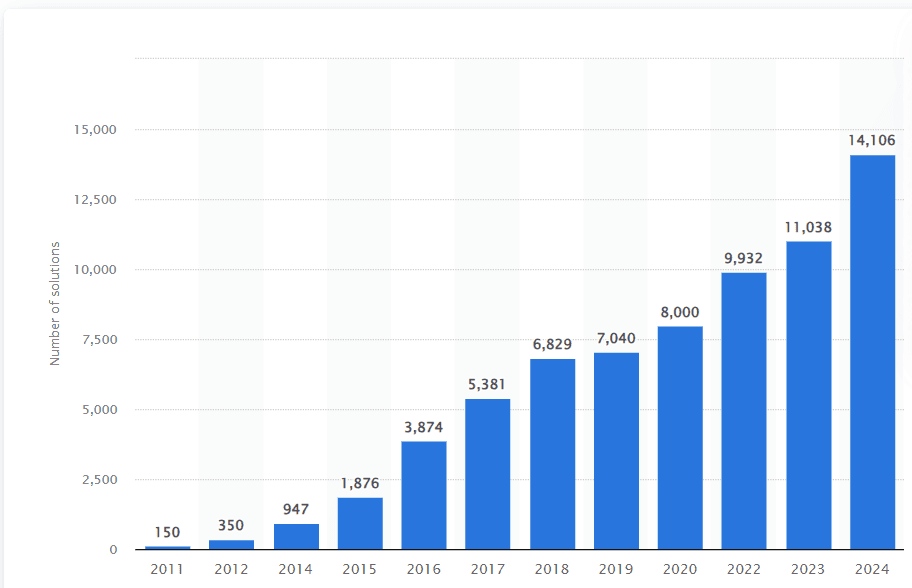Any adjustment to an IT architecture strategy should always serve a business purpose. A planned change therefore serves the goal of remaining competitive and positioning your brand (even) better in the market. However, the reason for the change should never be that other market participants are doing the same or that system XY is currently in vogue. Against this backdrop, this article presents one possible scenario among many in connection with the end of support for SAP Commerce.
Disadvantages of monolithic e-commerce systems
A fundamental driver is the further development of digital commerce. Technological progress and increasing specialization in individual digital commerce processes have caused the number of technology providers to skyrocket in recent years. As the following chart from Statista shows, the number of marketing solution providers, for example, has increased almost fifteenfold in the last 10 years:

The integration of such systems increasingly poses challenges for legacy systems when it comes to integrating and orchestrating multiple applications.
Of course, monolithic commerce systems still exist today that are very well integrated into a company's IT architecture. Paradoxically, these systems are still in operation because various platform functionalities were outsourced at an early stage. Nevertheless, these areas that are no longer needed are still included in the platform. This paradigm results in a number of fundamental disadvantages for such e-commerce systems:
Lack of flexibility:
Monolithic systems consist of a single, coherent, and often “closed” code base. Any change or adjustment in one area of the system can have unforeseen effects on other parts, making further development difficult. Implementing new features or responding to market changes thus becomes a complex and time-consuming task.
Limited scalability:
Since all functions and services are integrated into a single system, scaling part of the system can affect the performance of the entire system. This often leads to inefficiencies and high operating costs. Dependence on a single provider: Many monolithic platforms are proprietary and tie companies to a specific provider. This limits the freedom to choose the best technologies for specific requirements and often leads to higher costs.
Long development cycles:
Due to the complexity and close interconnections within the system, development cycles often take a long time. New features, bug fixes, or updates can be delayed, which puts companies at a competitive disadvantage.
SAP Commerce Migration: No more time-consuming updates
One characteristic of monolithic systems is the cyclical release of new software versions. It is irrelevant whether the system is still hosted on-premise or already in the manufacturer's cloud. Due to the high degree of customization, each upgrade means time and money for the company to keep the system up to date. With each new version that introduces new functionalities into the monolith – which may not even be needed – the risk of having to make your own adjustments to the front and back end also increases. In the worst case, this leads to a decline in the user-friendliness of the commerce system and a loss of revenue. In principle, every custom development goes against the standard processes of the existing system, which increases complexity even further. This is exactly where the service-oriented approach of composable commerce platforms comes in.
The advantages of composable commerce
High flexibility:
Companies can select the best components for their specific requirements and integrate them seamlessly. This “best-of-breed” approach makes it possible to respond quickly to changes and deploy new technologies without having to rebuild the entire system.
Scalability:
Since the individual components work independently of each other, they can be scaled individually. For example, if traffic to the product pages increases, only this part of the system can be scaled without affecting the rest. Independence from providers: By using open standards and APIs, companies are no longer tied to a single provider. They can easily integrate new solutions or replace existing components without having to rebuild the entire system.
Faster innovation cycles:
Thanks to the modularity of composable commerce, companies can implement new features more quickly. Changes in one component do not affect other parts of the system, which significantly shortens development cycles.
Migration strategy: From SAP monolith to composable commerce
The transition from a monolithic system to a composable commerce approach will be complex. The technical development effort in the legacy system ultimately reflects a company's business processes. However, the depths of the system's code often conceal functionalities from processes that have long since been replaced and are no longer used. To ensure a smooth transition, companies should consider the following best practices:
Prioritize business requirements:
Identify the most important functions of your existing solution and start migrating the components that have the greatest impact on business results. This allows companies to quickly reap the benefits of the new system, while the migration of less critical parts takes place gradually.
Make-or-buy decision for individual functions:
When extracting functions from the monolith, the question arises as to whether the functionality can be provided by an external service or must be developed in-house. As a general rule, the more individual and important the individual function is for the e-commerce business, the more likely it is that it should be developed in-house.
Step-by-step migration:
Instead of rebuilding the entire system at once, companies should proceed step by step. Based on prioritized business requirements, a roadmap is created that can be used to request only the relevant resources. A step-by-step approach makes it possible to identify and resolve problems early on before they have a major impact.
Integration and interoperability:
Ensure that the new components can be seamlessly integrated into the existing system. API-based architectures and orchestration engines are crucial here to ensure interoperability between the various modules.
Training and change management:
Switching to a new system requires not only technical adjustments, but also a change in working methods. Start early to accompany the change with active change management in order to minimize resistance and promote acceptance.
Monitoring and optimization:
After migration, it is important to continuously monitor the performance of the new system. Use analytics and metrics to evaluate the success of the migration and identify areas that can be further optimized. The complete “big bang” switch to a composable commerce solution is a scenario that will not be pursued further at this point.
Conclusion: Future-proof e-commerce architecture with composable commerce
The end of support for SAP Commerce on-premise offers companies the opportunity to review their e-commerce architecture and make strategic decisions. The transition from a monolithic e-commerce system to a composable commerce approach provides companies with the flexibility, scalability, and innovation that are essential in today's competitive landscape.
The transformation affects not only technology, but also the entire company and its processes. A step-by-step migration can create an optimal cost/benefit ratio and minimize risks. In the long term, Composable Commerce offers a future-proof platform that enables companies to adapt quickly to new market requirements and always offer their customers the best possible experience.
